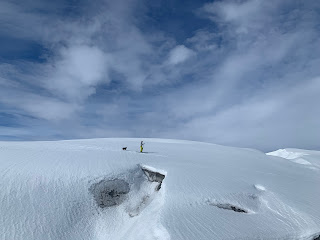We got funded to return to Greenland with the goal of better characterizing what drives the seasonal variability of ice flow. Most of that work is remote sensing and modeling. But we are also hoping to get some detailed measurements of ice flow.
The trip did not start out well. We boarded a military C-130 aircraft to get to Greenland. But a fuel stop in Goose Bay (Canada) turned into an unexpected three day stop, because of a mechanical airplane issue.

But when we finally got to Ilulissat, we had one of these magical evenings by the ice fjord.

Unfortunately that didn't last. The weather turned bad and never really improved much. We had to go home almost empty handed. One day it cleared up enough to fly to the calving front and put up some cameras
Looking down at the ice in the terminus area with its strange ribbon structure.
The calving front:

























